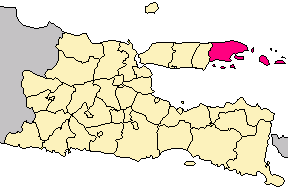Top Qs
Timeline
Chat
Perspective
Sumenep Madurese
East Madurese dialect From Wikipedia, the free encyclopedia
Remove ads
Sumenep Madurese is a Madurese dialect spoken by the Madurese people in Sumenep Regency, as well as the islands located to the east of Madura.[1] This dialect is closely related to the Situbondo dialect which is spoken in the easternmost region of Java.[2]
The Sumenep dialect is used as a standard reference for the Madurese language, because in the past Sumenep was the center of the Madurese kingdom and culture, and is also considered the 'most refined language' compared to other dialects.[3]
Remove ads
History
Madurese language has several dialects. However, among these dialects, the East Madurese dialect, namely Sumenep, is considered the standard reference for the Madurese language. This standardization has existed since the Dutch colonial era. In addition, the East Madurese (Sumenep) dialect has the highest language level. Like the language level engghi-bhunten which was once a means of communication between the people and their king, and it originated from the Sumenep Palace.[3]
During the Dutch colonial era, this was reinforced by the issuance of the Decree (besluit) of the Kingdom of the Netherlands Number 44 Article 1, dated 21 September 1892, and the Decree of the Dutch East Indies: Staatblad the Dutch East Indies 1893, Article 6: That the East Madurese or Sumenep Madurese is the standard Madurese language.[3]
Remove ads
Vocabulary
Kinship vocabulary
Madurese greetings at the Sumenep Palace include the following greetings used in kinship vocabulary.[4]
Color vocabulary
The vocabulary units for colors in the Sumenep Madurese generally take the form of words to mark the main color and phrases to mark the derived colors. Primary colors consist of 6 basic colors that have an implicit hierarchical order, as well as 3 non-basic colors.[5]
Remove ads
Characteristic
The difference in the lexicon in the Sumenep dialect compared to other dialects, for example the use of the words jang-ghujangan 'lying around', aoroq 'massage', whereas in the Pamekasan dialect the words dung-tedungan 'lying around' and apecet 'massage' are used. Meanwhile, the known phonological differences in the Sumenep dialect include the words baqariq 'yesterday' and ban 'and', whereas in the Bangkalan dialect the words bariq 'yesterday' and biq 'and' are used. Apart from that, the intonation in the Sumenep dialect also shows the use of a prolonged rhythm at the end of the syllable in the final word of the utterance.[6]
The Sumenep dialect has a habit or characteristic of lengthening the pronunciation of words at the end, generally in words that end in a vowel, such as ghaneko called ghanekoo.[1]
See also
References
Wikiwand - on
Seamless Wikipedia browsing. On steroids.
Remove ads

